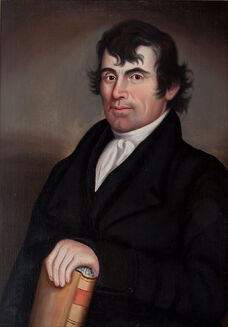
General Benjamin McKinley Logan, Sr. (May 1, 1743 - December 11, 1802) was an American pioneer, soldier, and politician from Shelby County, Kentucky. As colonel of the Kentucky County, Virginia militia during the American Revolutionary War, he was second-in-command of all the militia in Kentucky. He was also a leader in Kentucky's efforts to become a state. His brother, John, was the first state treasurer of Kentucky.
Benjamin Logan was born in Augusta County, Virginia, the eldest son of David and Jane (McKinley) Logan. His father died when Benjamin Logan was 15, and he inherited the family's 860 acre farm. He married Ann Montgomery in 1772; they had eight children.
Logan served in the Virginia militia during Henry Bouquet's 1764 campaign against the Shawnee Indians. Ten years later, he served as a lieutenant in Lord Dunmore's War against the same Indian nation. In 1776, Logan moved to Kentucky, then the westernmost portion of Virginia. He built a stockade known as Logan's Fort, which eventually would grow into the town of St. Asaph's, near Stanford.
In 1776, Logan was appointed sheriff of the county and a justice of the peace. During the American Revolution, he was the second ranking officer in the Virginia militia for Kentucky County, taking part in the defense of the settlements against attacks made by British-led Indians. He also joined in campaigns against hostile Indians north of the Ohio River, serving under George Rogers Clark. However, Logan and Clark frequently disagreed over strategy.
After American independence, Logan became active in the campaign to establish Kentucky as a separate state. He served as Kentucky's representative in the Virginia House of Delegates from 1781 until 1787, when he began arguing for statehood.
In October 1786, Logan led a force of Kentucky mounted militiamen against the Shawnee towns in the Ohio Country along the Little Miami River and Mad River (Logan's Raid). These were lightly defended, since most warriors had left to defend the villages of Chief Little Turtle from a separate force moving up the Wabash River under the command of General George Rogers Clark. Logan seized and burned thirteen villages, full of mostly women and children, destroying the food supplies, and killing or capturing many, including the aged Chief Moluntha, who surrendered under a US flag outside his wegiwa while displaying the Shawnee copy of the Treaty of Fort Finney (1785). Unfortunately, while under the protection of Logan's men, Captain Hugh McGary slipped through the guard and murdered the Shawnee chief. The death of their chief infuriated the Shawnee, who retaliated by redoubling their attacks against the whites, and escalating the Northwest Indian War.
Logan was one of those calling for the Danville Convention, and was a delegate when it wrote the first Kentucky constitution in 1791 and 1792. Following statehood, he served in the Kentucky House of Representatives from 1792 to 1795. He ran unsuccessfully for governor in 1796 and 1800. In 1802, Benjamin Logan died of a stroke at age 60, at his home 6 miles southwest of Shelbyville, Kentucky. He was buried in the family cemetery.